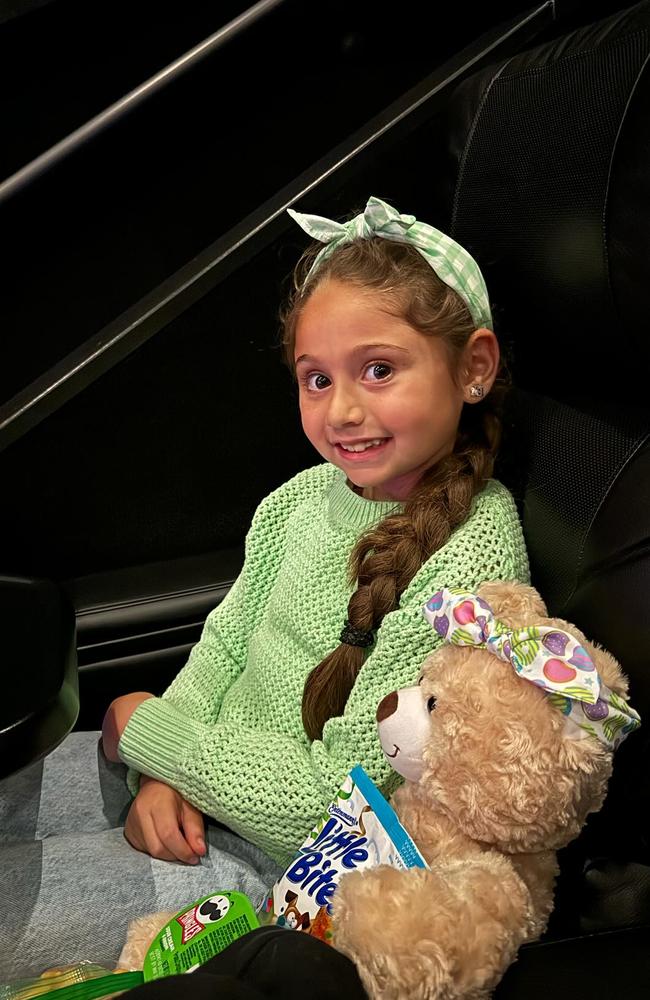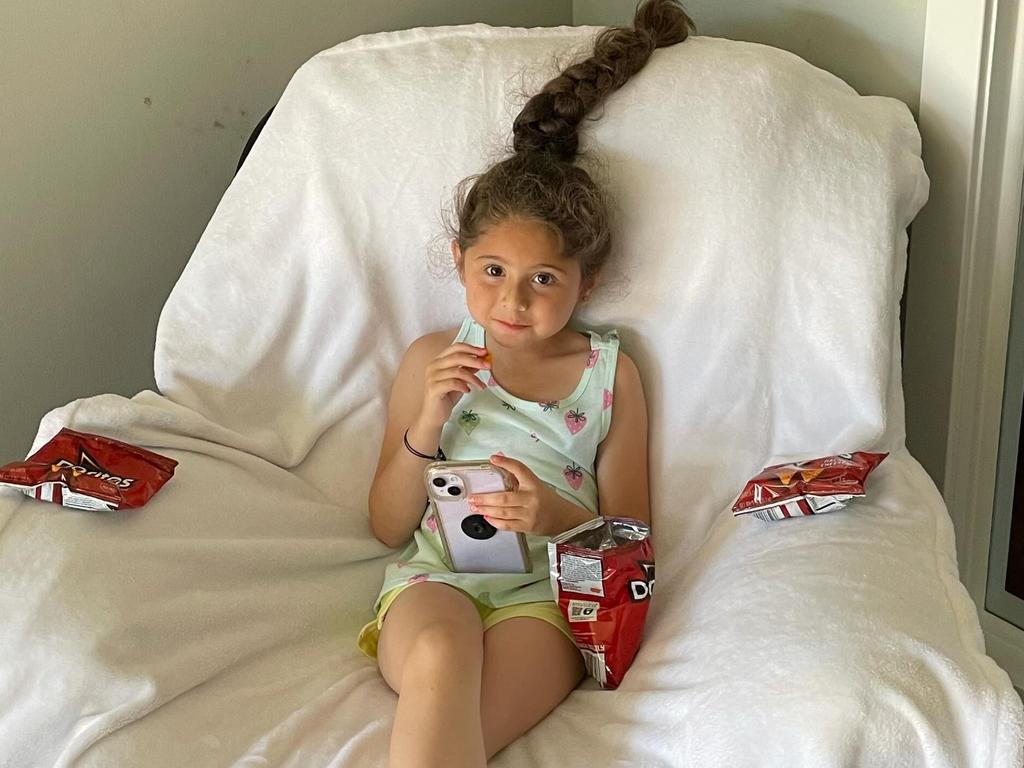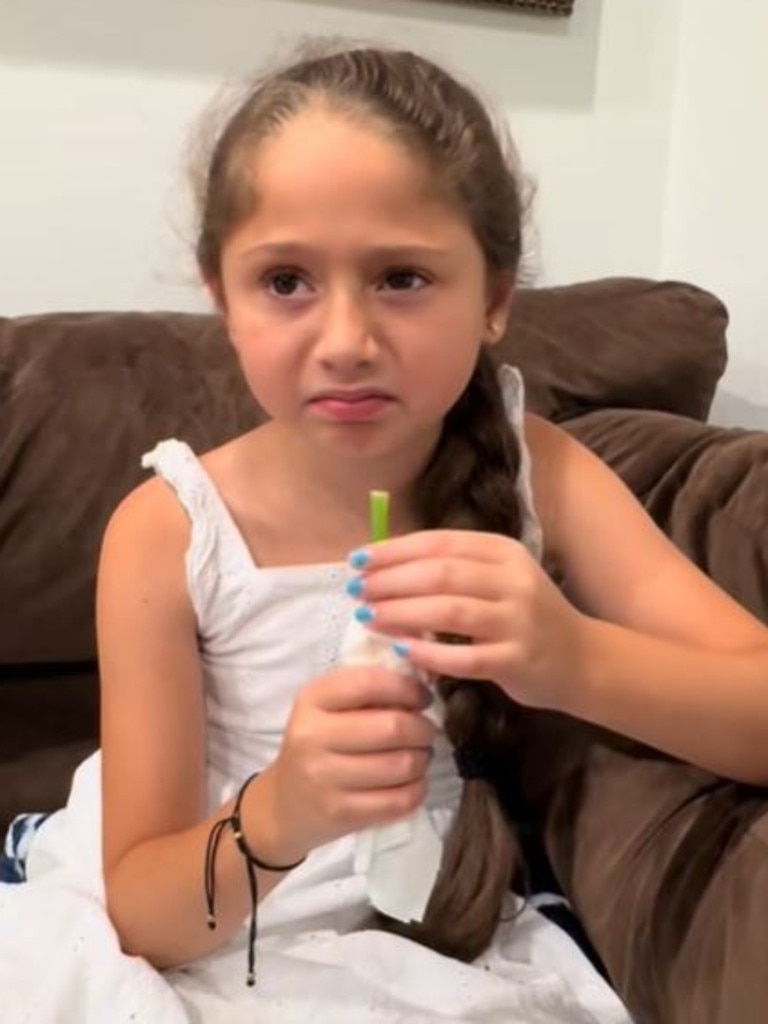Reason Californian girl, 8, is going viral over food video
There is a bittersweet reason why a video of an eight-year-old trying a stick of honey is going viral on social media.
There is a bittersweet reason why a video of an eight-year-old trying a stick of honey is going viral on social media.
Hannah, from California, is diagnosed with an eating disorder called Avoidant/Restrictive Food Intake Disorder (ARFID).
The condition is not associated with body image concerns as many eating disorders are.
Instead, it had to do with food avoidance due to low appetite, fear of consequences such as choking or sensory issues including not liking the texture or smell of the food.
Hannah documents her attempt at overcoming this on social media with a clip of her trying a green apple honey stick clocking up more than half a million views.
The primary school student didn’t enjoy honey when she tried it but after seeing honey sticks, which she knows her school friends enjoy, she was determined to give it another go.
“Not only is this honey but it’s also green and it’s sticky so I decided to hold it with a napkin,” Hannah told her followers.
Hannah took a small bite and began shaking her head but the determined little girl didn’t give up at the first hurdle. She went in for a second bite. Her face twisted in disgust and she appeared to be on the verge of tears, gagging at the taste.
“It’s too bitter and the texture is like too liquidy and wet and it’s also really sticky. I rate this a 4.3 out of 10.”
But the little girl was still proud of herself for doing her three taste tests. In recent videos, she has also tried different types of cherries, homemade burgers, chocolate macaroon and honeydew melons. Hannah’s also trying to find a drink she enjoys besides water.

Hannah is the youngest of three siblings, all with various needs surrounding food. Hannah’s oldest brother has autism and didn’t start eating until he was three with feeding therapy intervention. He has now massively expanded his palate.
Meanwhile the middle sibling is not a picky eater at all but, like most kids, hates fruit and vegetables.
However feeding therapy was a very “traumatic” and “painful” experience for Hannah.
“I decided that feeding therapy was doing more harm than good so we stopped that but when she was doing it one of the things that motivated her was us saying things like ‘let’s take a video and send it to your therapist’,” Michelle revealed in a 10-minute long TikTok video.
She said her daughter would do what she needed for the camera but her mother never sent it anywhere. But, when Hannah was four, her growth chart started going in the wrong direction.
Her mother did everything she could to encourage Hannah to eat, saying she would’ve let Hannah eat ice cream and chips 10 times a day if it meant she put on some weight. But even that wasn’t working.

So, at the end of 2023, the Californian family were driving by a Chick Fil-A, with Michelle asking Hannah if she wanted to film a video.
“She started crying and getting very upset, and finally opened up to us and said, ‘Every time you talk about food it makes me really anxious’,” Michelle recalled.
“And I could feel this emotion coming from her and I didn’t realise how bad it was impacting her.”
Michelle realised a lot of things were going on under the surface so she began to research and began to suspect her daughter had ARFID and look for an eating disorder specialist. Eventually, Michelle found a psychologist in another state who specialised in ARFID so they started meeting with her twice a week on Zoom.
In January, Michelle said the family was still trying to get to the root of where the anxiety stemmed from. The psychologist educated them on the need to increase Hannah’s weight using supplements otherwise there would be a need for a feeding tube, which scared the eight-year-old.

Hannah revealed her top five fear foods include broccoli, mayonnaise, jam, beans and peanut butter.
But, now, she has captured the world’s heart as she does her best to push herself to try new foods. She’s built a community, which initially was created for Hannah to get support from friends and family, for others who experience the same.
“Thank you for doing this. There is a lot of wrong information and it causes distressing situations for people with ARFID symptoms,” one social media user said.
Another added: “Love this. I’m 20 and just starting to get through recovery with ARFID, absolutely love it awareness and support in your family.”
“As someone with ARFID I can’t tell you enough how brave your little girl is, what she is going through is the most debilitating experience since it’s so misunderstood. She should be so proud,” one added.
Grace Collinson, Clinical Program Manager at Butterfly Foundation, told news.com.au there is a lack of awareness about ARFID as it was only considered a diagnosable eating disorder in 2013.
She said it’s more than just “picky eating” and can have some serious health consequences such as significant weight loss, dependence on oral nutritional supplements or tube feeding.


“Working out whether someone might have ARFID or is just a fussy eater can be difficult, especially in children, but will usually manifest in an extreme aversion to or lack of interest in food and is a cause for concern when it affects their ability to meet their energy and nutritional needs, resulting in weight loss, malnutrition or an inability to maintain growth and development,” Ms Collinson said.
“Some signs that may indicate someone is struggling with ARFID include: being a very selective eater, having strong negative reactions to smells, tastes, textures, or colours of foods, being highly fearful of new and unfamiliar foods, lack of interest in eating and have a very low appetite, a fear of what might happen when they eat; for example, experiencing pain, choking, or vomiting.
“Some people may show multiple signs or only one sign of ARFID and while many people may be underweight, some can sustain a normal weight from their limited diet.”

Like other eating disorders, ARFID doesn’t discriminate and can impact anyone regardless of age, gender or weight. She said ARFID often occurs alongside other conditions with research showing that 21 per cent of people with autism experience ARFID and 26 per cent of people with ADHD experience the eating disorder.
She said research is still growing surrounding treatment for ARFID but so far evidence suggests that cognitive behaviour therapy, which may include food exposure therapy like Hannah does, works.
Another kind of therapy that research suggests helps is responsive feeding therapy, which involves establishing mealtime routines with pleasant interactions and few distractions, modelling mealtime behaviour, and allowing the child to respond to hunger cues.
“Butterfly’s recent Paying the Price Report shows that there are 31,341 people in Australia diagnosed with ARFID in 2023, making up 3 per cent of the 1.1 million people in Australia with eating disorders,” Ms Collinson said.
“However, the ARFID prevalence estimate is likely to be underestimated, as research on prevalence for ARFID is particularly limited given it was only recently listed as a diagnosable eating disorder in the Diagnostic and Statistical Manual of Mental Disorders fifth edition (DSM-5) in 2013.”






